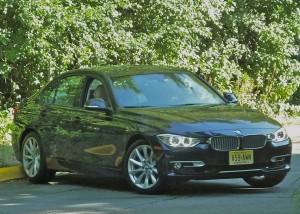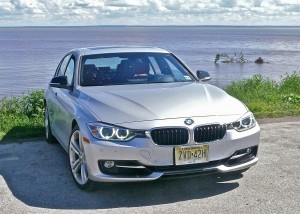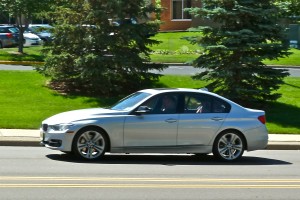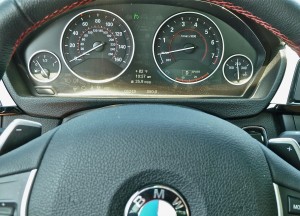Which BMW 3 is better? Flip a coin.
By John Gilbert
The BMW 3-Series has risen to a position above and beyond the prestige of a normal icon. The “3” design tips off everyone that the car inside will perform and handle with something approaching flawless precision. The car’s reputation is such that all other manufacturers tend to introduce cars by claiming that they used the BMW 3-Series as their benchmark for handling.
BMW introduced the 3-Series with a press drive that included hot laps around Mazda Laguna Seca road-racing track, and further drives along the Pacific Coast Highway south of Monterey to Big Sur — one of the most scenic highways in the world.
Even then, however, I couldn’t wait for the chance to test-drive a 3-Series on Lake Superior’s North Shore, which happens to be my favorite scenic highway, and besides, it’s closer to home. The car comes with optional all-wheel drive, but in the midst of the hottest July on record in Minnesota, the traditional rear-drive was more than just fine.
At that, I was not fully prepared for what was to come when I got to spend a week driving the 6-cylinder BMW 335i. Two weeks later, I also got the chance for a week driving the 4-cylinder BMW 328i.

Less-expensive (slightly) and less potent (also slightly) 328i shares body and features with the 335i.
From the introductory tests, it seemed to me that the turbocharged 4 had sufficient power to eliminate any need for the more powerful BMW 335i, and it must be more economical too, right?
Not long after that, the pair of BMW 3s turned my assumptions upside down, and back again.
First, we had the 335i, with the priceless BMW inline 6-cylinder engine, measuring 3.0 liters of displacement, with dual-overhead camshafts operating the 24 valves.
While “just” a 4-door sedan, the 335i has something of a menacing look, and the drivetrain remains its inner jewel. One of the world’s truly fine engines, the 3.0 has TwinPower turbo technology, high-pressure precision direct injection, Valvetronic valvetrain, and Double VANOS t variable valve timing on both intake and exhaust valves. The 3-Series can be had with any flavor of 3.0-liter engines. The test car is twin-turbocharged, boosting power up to 300 horsepower and 300 foot-pounds of torque, allowing it to zip around with power and class.
The sticker shock reads $42,400 for base price, with options pushing the final tag to $55,870. That’s a lot, but it seems more reasonable after you spend some time appreciating the basic car plus the added features.
Driving on metropolitan highways and streets, the 335i exudes a certain class that approaches hotter sports cars and is far above normally recognized sporty sedans. Handling is flawless, which is no surprise, and while the car is smaller than most midsizers and more like a compact, although rear seat room is certainly adequate.
Performance is smooth and precise, harnessed by the Sport Line’s adaptive suspension off the M3 design, and with the Sport automatic transmission, which has eight speeds. Drivers can control things with paddles mounted within thumb’s reach on the steering wheel. I only really pushed the car once, and that was coming easterly on I-610 north of Minneapolis, where taking the Duluth exit north requires a left exit, which winds onto an overpass before curving gradually to the right, then more sharply, before finally hooking in a decreasing-radius arc. It is not what traffic engineers could possibly have thought would be the safest alternative for normal cars, but it is squeezed into a tight bit of real estate and is pure pleasure in a great-handling car.
Knowing the curve well, and having the pleasure of nobody around me, fore or aft, I went into the last part of the turn where the sign advises 25 mpg; I had downshifted a couple times, but was still going more like 47 mph. The car was so planted that I accelerated hard the rest of the way around, and we sailed onto Interstate 35 smoothly. It was close to breathtaking.
You can cheat with that engine, using console controls to push a button to engage “sport,” or clicking another one to get “sport plus.” I would recommend sport plus only on perfectly smooth surfaces, or at a race track. But sport works just fine as a compromise to quicken and raise shift points and tighten the suspension.
The 335i is filled with features to aid connectivity, and it was easy to hook up my iPhone to the system, allowing me to make and receive calls through the audio system, without taking my hands off the wheel.
Driving back from Duluth to Minneapolis, I cruised within the speed limit, and through the highway construction maze that reduced much of the speed to a crawl. I didn’t expect great fuel economy, but I reset the computer just for that 160-mile trip, and coaxed the number to creep upward. When I finally reached my planned exit, the digital readout went from 35.9 to and even 36.0 mpg.
That’s right, a hot sporty sedan that is surprisingly capable of attaining 36.0 miles per gallon on a freeway trip. Suddenly, my whole anticipation for the two almost back-to-back BMWs took an abrupt detour. On to other things, I awaited the arrival of the 328i, fully intending to give it a fair test, but my idea of: “Why would anyone pay extra for the 6 when the 4 is more than adequate?” had changed to: “Why would anyone spend a lot of money and settle for the 4, when the 6 will get 36 mpg”
Then the 328i was delivered to me. The 4 is not just a 4, but a 2.0-liter gem that also gets twin turbocharging, and delivers 240 horsepower and 255 foot-pounds of torque. That may not sound like much, but it’s plenty — especially in a lean and agile sedan, where the torque reaches its peak at a mere 1,250 RPMs. When full torque comes in that early, and stays there as if on a plateau, the feeling is more like having a much larger engine at work. The twin-scroll turbo, which scoops up more exhaust force after the first turbo spins off the initial exhaust, is helped by direct injection and sends the 328i 0-60 in a reported 5.7 seconds — approaching the 5.4-second burst by the larger twin-turbo-6.

The 328i has very groovy optional woodgrain, and both cars share the odd shift-knob control and refined iDrive.
The transmission is also the 8-speed, with the same weird shift knob controlling it — one of the very few unlikely counter-intuitive gadgets so unlike traditional BMW ideas, and ranks among the most curious ideas BMW has executed since the “I-Drive” console control knob that has confused everyone with its complexity for a decade. The problem with the shift knob is that it has a clear pattern displayed on top of the knob, showing P, R, N, D. Simple, right? It implies that if you nudge the shift lever up from D, through N and R, that you might then be in P, for Park. Wrong, Heinrich! Moving the shift lever forward as hard and far as it will go will never get you into P. You must instead click the special P button on the top of the shift knob, and you can do that any time, even if the lever is in D or N.
My biggest gripe was that after I became reasonably instinctive about clicking the P button was that I only had about 80-percent success when I did park and click that button, because it didn’t always engage. One time I was hustling to run into the studio to do a radio broadcast, and swiftly clicked “P” and hopped out, and sensed immediately that the car was starting to roll backwards. Sure enough, “P” had not engaged despite my firm click, and the car was still residing in “R.” The danger of thinking the car is in P and it really isn’t probably don’t need to be explained.
It’s the same coming out of P, when you have to click a little electric switch on the left side of the shift knob to free the lever to go where you’re intending to place it. At least when you’re locked into park there’s no risk of caving in the grille of the car in the metered spots ahead or behind you.
Ah, but once underway, all is well. In fact, it is more than well, because you have some other buttons at your command. There is an innocent little switch on the left edge of the console that identifies Sport, Comfort, or Eco. Click Eco, and the car’s shift points are slooowwwed down, approaching docile behavior, for optimum fuel mileage. Comfort is pretty much normal peppy performance. Click Sport, and you get a distinct change in shifting algorithm, suspension, and steering, into a definite fun-to-drive mode. Click the Sport button a second time and you get Sport Plus, which snaps you to attention by putting you into what I’d call race-track mode.
Both cars, with their twin-turbo power, shut down the engine if you stop completely at a red light, and there is brake-energy regeneration to bolster the electrical system.
The 328i was not up to the 335i for outright performance, but it was in the ballpark. For that, I was wavering back to favoring the 4, despite an extremely weird optional interior scheme. I love real wood accents, but this wood has a 3-D effect, with the grain raised in such dramatic ridges that a fool might think it was some sort of irregular corduroy trim on the dash, doors and console. The optional FineLine Pure wood trim should be observed before selecting.
Sticker price of the base 328i is a reasonable $34,900, although the test car came with leather interior, sports leather steering wheel, the parking package with distance control and side and top-view cameras, plus premium package keyless entry, moonroof and front seats, and a premium sound package by Harmon Kardon, with navigation system and heads-up display. When it was all tallied up, including the $895 destination price, the sticker showed $49,870 — more than the base price of the 335i, but thankfully less by $6,000 than the 335i sticker.
That, again, caused my comparison-minded brain to do another flip-flop and pretty much stop in between, like an NBC Olympic video replay frozen in time, deciding on the better question. Should we ask: Why would anybody choose the 335i 6 when the 328i 4 is nearly as potent? Or should it be: Why would anybody choose the 328i 4 when the slightly costlier 335i 6 can deliver great fuel economy on its own?
The coup de grace, however, was still to come during the second part of our impromptu fuel-economy runs. My wife, Joan, gives me valuable input on all test vehicles, and at great personal sacrifice, I asked her to drive the 328i from Minneapolis to Duluth, fully anticipating the 4 might have to strain to match the 335i’s fuel economy of 36.0.
She reported by cell phone that she, too, was caught in the various construction slowdowns on I-35, and she confessed that when free of such obstacles, she joined the traffic flow sailing along at about 76 mph. When she got to Duluth she checked the on-board computer, which she had zeroed, in the 4-cylinder 328i.
“It said I got 42.5 miles per gallon!” she said.
Amazing, once again. I have driven a number of contemporary subcompact economy cars, and even some hybrids, that wouldn’t get 40 mpg even when pampered. And here’s a hot, sporty, twin-turbo BMW sedan hitting 42.5. When I checked, the EPA estimates for both cars shows 23 mpg city and 33 highway.
So the quiz expands. The only question remaining is: Which should you choose, between the BMW 328i and the BMW 335i? The answer for sophisticated sporty-sedan customers is: Don’t waste time deliberating, just pick either one.
Comments
One Comment on Which BMW 3 is better? Flip a coin.
-
Frozen beverages on
Thu, 19th Mar 2015 10:25 pm
Hi to all, the contents present at this web site are truly remarkable for people knowledge, well,
keep up the nice work fellows.
Also visit my weblog: Frozen beverages
Tell me what you're thinking...
and oh, if you want a pic to show with your comment, go get a gravatar!






 John Gilbert is a lifetime Minnesotan and career journalist, specializing in cars and sports during and since spending 30 years at the Minneapolis Tribune, now the Star Tribune. More recently, he has continued translating the high-tech world of autos and sharing his passionate insights as a freelance writer/photographer/broadcaster. A member of the prestigious North American Car and Truck of the Year jury since 1993. John can be heard Monday-Friday from 9-11am on 610 KDAL(www.kdal610.com) on the "John Gilbert Show," and writes a column in the Duluth Reader.
John Gilbert is a lifetime Minnesotan and career journalist, specializing in cars and sports during and since spending 30 years at the Minneapolis Tribune, now the Star Tribune. More recently, he has continued translating the high-tech world of autos and sharing his passionate insights as a freelance writer/photographer/broadcaster. A member of the prestigious North American Car and Truck of the Year jury since 1993. John can be heard Monday-Friday from 9-11am on 610 KDAL(www.kdal610.com) on the "John Gilbert Show," and writes a column in the Duluth Reader.